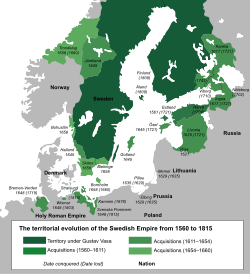Kingdom of Sweden Konungariket Sverige (Swedish) | |||||||||
|---|---|---|---|---|---|---|---|---|---|
| 1611–1721 | |||||||||
 | |||||||||
| Capital | Stockholm | ||||||||
| Common languages | Swedish | ||||||||
| Religion | Church of Sweden (official) | ||||||||
| Government |
| ||||||||
| King/Queen | |||||||||
• 1611–1632 (first) | Gustavus Adolphus | ||||||||
• 1632–1654 | Christina | ||||||||
• 1654–1660 | Charles X Gustav | ||||||||
• 1660–1697 | Charles XI | ||||||||
• 1697–1718 | Charles XII | ||||||||
• 1718–1720 | Ulrika Eleonora | ||||||||
• 1720–1721 (last) | Frederick I | ||||||||
| Legislature | Riksdag of the Estates | ||||||||
| History | |||||||||
• Gustavus Adolphus ascends the throne | 30 October 1611 | ||||||||
| 29 July 1634 | |||||||||
• Queen Ulrika Eleonora abdicated | 24 March 1720 | ||||||||
| 2 May 1720 | |||||||||
| 10 September 1721 | |||||||||
| Currency | Riksdaler | ||||||||
| |||||||||
| History of Sweden |
|---|
 |
| Timeline |
|
|
The Swedish Empire or the Age of Greatness (Swedish: stormaktstiden)[1] was the period in Swedish history spanning much of the 17th and early 18th centuries during which Sweden became a European great power that exercised territorial control over much of the Baltic region. During this period it also held territories on the North Sea and some overseas colonies, including New Sweden. The beginning of the period is usually taken as the reign of Gustavus Adolphus, who ascended the throne in 1611, and its end as the loss of territories in 1721 following the Great Northern War.[1]
After the death of Gustavus Adolphus in 1632, the empire was controlled for lengthy periods by part of the high nobility, such as the Oxenstierna family, acting as regents for minor monarchs. The interests of the high nobility contrasted with the uniformity policy (i.e., upholding the traditional equality in status of the Swedish estates favoured by the kings and peasantry). In territories acquired during the periods of de facto noble rule, serfdom was not abolished, and there was also a trend to set up respective estates in Sweden proper. The Great Reduction of 1680 put an end to these efforts of the nobility and required them to return estates once gained from the crown to the king. Serfdom, however, remained in force in the dominions acquired in the Holy Roman Empire and in Swedish Estonia, where a consequent application of the uniformity policy was hindered by the treaties by which they were gained.
After its victories in the Thirty Years' War and the subsequent Peace of Westphalia Sweden was granted territories in northern Germany. Sweden reached the height of its power during the Second Northern War, when its primary adversary, Denmark–Norway, was neutralized by the Treaty of Roskilde in 1658. Denmark–Norway was forced to give up a third of its territory to save the rest.[2] Although the reign of Charles XII would see initial Swedish victories in the Peace of Travendal (1700) and the Treaty of Altranstädt (1706), he would go on to lead a campaign in Russia that would end in a staggering defeat for the Swedes. The Russian victory at the Battle of Poltava put an end to Sweden's eastbound expansion, and by the time of Charles XII's death in 1718 the Empire had been severely diminished both territorially and militarily. The last traces of occupied continental territory vanished during the Napoleonic Wars, and Finland was ceded to Russia in 1809, marking the end of Sweden’s period as a great power.
- ^ a b Frost, Robert I. (2000). The Northern Wars. War, State and Society in Northeastern Europe 1558–1721. Longman. pp. 133–134. ISBN 978-0-582-06429-4.
- ^ Nicklas, Thomas (2002). Macht oder Recht. Frühneuzeitliche Politik im obersächsischen Reichskreis [Power or Right: Early modern politics in the Upper Saxon Circle] (in German). Stuttgart. p. 282.
Finanziell völlig von französischen Subsidien abhängig, wollte sich die Großmacht auf tönernen Füßen [...]
{{cite book}}: CS1 maint: location missing publisher (link)

